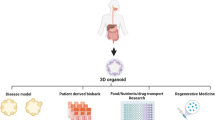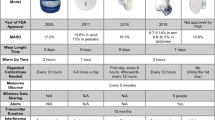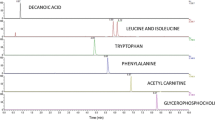Abstract
Metabolic diseases have been a major public health issue and a clinical challenge worldwide. Dysfunction of metabolic homeostasis is linked to the onset of various diseases because the various metabolizing organs synchronously interact to maintain metabolic homeostasis. Therefore, understanding inter-organ communication is important to develop more accurate drug testing and discovery for the treatment of metabolic diseases. The physiologically relevant organ-on-a-chip system is an emerging technology to study metabolic dynamics by providing an organ-level platform. This review summarizes the single- and multi-organ chip systems to study metabolic diseases and their dynamics, focusing on their inter-organ crosstalk.




Similar content being viewed by others
Data availability
Data is available on request from the authors.
References
Zhu, J., Thompson, C.B.: Metabolic regulation of cell growth and proliferation. Nat. Rev. Mol. Cell. Biol. 20, 436–450 (2019)
Shroff, T., et al.: Studying metabolism with multi-organ chips: new tools for disease modelling, pharmacokinetics and pharmacodynamics. Open Biol. 12, 210333 (2022)
Finkelstein, J., Gray, N., Heemels, M.T., Marte, B., Nath, D.: Metabolism and disease. Nature 491, 347 (2012)
Park, M., Heo, Y.J.: Biosensing technologies for chronic diseases. Biochip J. 15, 1–13 (2021). https://doi.org/10.1007/s13206-021-00014-3
Belete, R., Ataro, Z., Abdu, A., Sheleme, M.: Global prevalence of metabolic syndrome among patients with type I diabetes mellitus: a systematic review and meta-analysis. Diabetol. Metab. Syndr. 13, 25 (2021). https://doi.org/10.1186/s13098-021-00641-8
Hirode, G., Wong, R.J.: Trends in the prevalence of metabolic syndrome in the United States, 2011–2016. JAMA 323, 2526–2528 (2020). https://doi.org/10.1001/jama.2020.4501
Lee, M., et al.: Effect of food sensitivity on overweight assessed using food-specific serum immunoglobulin G levels. Biochip J. 15, 296–304 (2021). https://doi.org/10.1007/s13206-021-00028-x
Goga, A., Stoffel, M.: Therapeutic RNA-silencing oligonucleotides in metabolic diseases. Nat. Rev. Drug Discov. 21, 417 (2022)
Jang, M., Choi, N., Kim, H.N.: Hyperglycemic neurovasculature-on-a-chip to study the effect of SIRT1-targeted therapy for the type 3 diabetes “Alzheimer’s disease.” Adv. Sci. (Weinh) 9, e2201882 (2022)
Ingber, D.E.: Human organs-on-chips for disease modelling, drug development and personalized medicine. Nat. Rev. Genet. 23, 467 (2022)
Driver, R., Mishra, S.: Organ-on-a-chip technology: an in-depth review of recent advancements and future of whole body-on-chip. Biochip J. (2022). https://doi.org/10.1007/s13206-022-00087-8
Kang, S.M.: Recent advances in microfluidic-based microphysiological systems. Biochip J. 16, 13–26 (2022). https://doi.org/10.1007/s13206-021-00043-y
Tran, T.T.T., Delgado, A., Jeong, S.: Organ-on-a-chip: the future of therapeutic aptamer research? Biochip J. 15, 109–122 (2021). https://doi.org/10.1007/s13206-021-00016-1
American Diabetes, A.: Diagnosis and classification of diabetes mellitus. Diabetes Care 36(Suppl 1), S67-74 (2013)
DeFronzo, R.A., et al.: Type 2 diabetes mellitus. Nat. Rev. Dis. Primers 1, 15019 (2015)
Algenstaedt, P., et al.: Microvascular alterations in diabetic mice correlate with level of hyperglycemia. Diabetes 52, 542–549 (2003)
Lee, H.J., et al.: Diabetes and Alzheimer’s disease: mechanisms and nutritional aspects. Clin. Nutr. Res. 7, 229–240 (2018)
Alsharif, A.A., et al.: Prevalence and incidence of dementia in people with diabetes mellitus. J. Alzheimers Dis. 75, 607–615 (2020)
Roder, P.V., Wu, B., Liu, Y., Han, W.: Pancreatic regulation of glucose homeostasis. Exp. Mol. Med. 48, e219 (2016)
Mathis, D., Vence, L., Benoist, C.: beta-Cell death during progression to diabetes. Nature 414, 792–798 (2001)
Nikolic, I., Leiva, M., Sabio, G.: The role of stress kinases in metabolic disease. Nat. Rev. Endocrinol. 16, 697–716 (2020)
Visser, M., Bouter, L.M., McQuillan, G.M., Wener, M.H., Harris, T.B.: Elevated C-reactive protein levels in overweight and obese adults. JAMA 282, 2131–2135 (1999)
Pradhan, A.D., Manson, J.E., Rifai, N., Buring, J.E., Ridker, P.M.: C-reactive protein, interleukin 6, and risk of developing type 2 diabetes mellitus. JAMA 286, 327–334 (2001)
Ouchi, N., Parker, J.L., Lugus, J.J., Walsh, K.: Adipokines in inflammation and metabolic disease. Nat. Rev. Immunol. 11, 85–97 (2011)
Curat, C.A., et al.: From blood monocytes to adipose tissue-resident macrophages: induction of diapedesis by human mature adipocytes. Diabetes 53, 1285–1292 (2004)
Iacobellis, G.: Epicardial adipose tissue in contemporary cardiology. Nat. Rev. Cardiol. (2022)
Hotamisligil, G.S.: Inflammation and metabolic disorders. Nature 444, 860–867 (2006). https://doi.org/10.1038/nature05485
Shoelson, S.E., Lee, J., Goldfine, A.B.: Inflammation and insulin resistance. J. Clin. Invest. 116, 1793–1801 (2006)
Cariou, B., Byrne, C.D., Loomba, R., Sanyal, A.J.: Nonalcoholic fatty liver disease as a metabolic disease in humans: a literature review. Diabetes Obes. Metab. 23, 1069–1083 (2021)
Moore, J.B.: Non-alcoholic fatty liver disease: the hepatic consequence of obesity and the metabolic syndrome. Proc. Nutr. Soc. 69, 211–220 (2010)
Wang, P.X., Deng, X.R., Zhang, C.H., Yuan, H.J.: Gut microbiota and metabolic syndrome. Chin. Med. J. (Engl) 133, 808–816 (2020). https://doi.org/10.1097/CM9.0000000000000696
Fan, Y., Pedersen, O.: Gut microbiota in human metabolic health and disease. Nat. Rev. Microbiol. 19, 55–71 (2021)
Farhadi, A., Vosough, M., Zhang, J.S., Tahamtani, Y., Shahpasand, K.: A possible neurodegeneration mechanism triggered by diabetes. Trends Endocrinol. Metab. 30, 692–700 (2019)
Sims-Robinson, C., Kim, B., Rosko, A., Feldman, E.L.: How does diabetes accelerate Alzheimer disease pathology? Nat. Rev. Neurol. 6, 551–559 (2010)
Huang, C.C., et al.: Diabetes mellitus and the risk of Alzheimer’s disease: a nationwide population-based study. PLoS ONE 9, e87095 (2014)
Panza, F., Lozupone, M., Logroscino, G., Imbimbo, B.P.: A critical appraisal of amyloid-beta-targeting therapies for Alzheimer disease. Nat. Rev. Neurol. 15, 73–88 (2019)
Kandimalla, R., Vani, T., Reddy, P.H.: Is Alzheimer’s disease a Type 3 diabetes? A critical appraisal. Bba-Mol. Basis Dis. 1863, 1078–1089 (2017)
Noury, J.B., Zagnoli, F., Petit, F., Marcorelles, P., Rannou, F.: Exercise efficiency impairment in metabolic myopathies. Sci. Rep. 10, 8765 (2020)
Angelini, C., Pennisi, E., Missaglia, S., Tavian, D.: Metabolic lipid muscle disorders: biomarkers and treatment. Ther. Adv. Neurol. Disord. 12, 1756286419843359 (2019)
Watt, K.I., et al.: Yap regulates skeletal muscle fatty acid oxidation and adiposity in metabolic disease. Nat. Commun. 12, 2887 (2021). https://doi.org/10.1038/s41467-021-23240-7
Kim, G., Kim, J.H.: Impact of skeletal muscle mass on metabolic health. Endocrinol. Metab. (Seoul) 35, 1–6 (2020). https://doi.org/10.3803/EnM.2020.35.1.1
De Felice, F.G., Goncalves, R.A., Ferreira, S.T.: Impaired insulin signalling and allostatic load in Alzheimer disease. Nat. Rev. Neurosci. 23, 215–230 (2022)
Aron-Wisnewsky, J., et al.: Gut microbiota and human NAFLD: disentangling microbial signatures from metabolic disorders. Nat. Rev. Gastroenterol. Hepatol. 17, 279–297 (2020)
Castillo-Armengol, J., Fajas, L., Lopez-Mejia, I.C.: Inter-organ communication: a gatekeeper for metabolic health. EMBO Rep. 20, e47903 (2019)
Longo, V.D., Panda, S.: Fasting, circadian rhythms, and time-restricted feeding in healthy lifespan. Cell Metab. 23, 1048–1059 (2016)
Ronveaux, C.C., Tome, D., Raybould, H.E.: Glucagon-like peptide 1 interacts with ghrelin and leptin to regulate glucose metabolism and food intake through vagal afferent neuron signaling. J. Nutr. 145, 672–680 (2015)
Kir, S., et al.: FGF19 as a postprandial, insulin-independent activator of hepatic protein and glycogen synthesis. Science 331, 1621–1624 (2011)
Chu, J.Y., Cheng, C.Y., Sekar, R., Chow, B.K.: Vagal afferent mediates the anorectic effect of peripheral secretin. PLoS ONE 8, e64859 (2013)
Tschop, M., Smiley, D.L., Heiman, M.L.: Ghrelin induces adiposity in rodents. Nature 407, 908–913 (2000)
Tokarz, V.L., MacDonald, P.E., Klip, A.: The cell biology of systemic insulin function. J. Cell Biol. 217, 2273–2289 (2018)
Gray, S.M., Meijer, R.I., Barrett, E.J.: Insulin regulates brain function, but how does it get there? Diabetes 63, 3992–3997 (2014)
Badman, M.K., et al.: Hepatic fibroblast growth factor 21 is regulated by PPARalpha and is a key mediator of hepatic lipid metabolism in ketotic states. Cell Metab. 5, 426–437 (2007)
Stern, J.H., Rutkowski, J.M., Scherer, P.E.: Adiponectin, leptin, and fatty acids in the maintenance of metabolic homeostasis through adipose tissue crosstalk. Cell Metab. 23, 770–784 (2016)
Chung, H.S., Choi, K.M.: Adipokines and myokines: a pivotal role in metabolic and cardiovascular disorders. Curr. Med. Chem. 25, 2401–2415 (2018)
Whitesides, G.M.: The origins and the future of microfluidics. Nature 442, 368–373 (2006). https://doi.org/10.1038/nature05058
Knowlton, S., Yenilmez, B., Tasoglu, S.: Towards single-step biofabrication of organs on a chip via 3D printing. Trends Biotechnol. 34, 685–688 (2016). https://doi.org/10.1016/j.tibtech.2016.06.005
Kang, S., Park, S.E., Huh, D.D.: Organ-on-a-chip technology for nanoparticle research. Nano Converg. 8, 20 (2021). https://doi.org/10.1186/s40580-021-00270-x
Marx, U., et al.: Biology-inspired microphysiological systems to advance patient benefit and animal welfare in drug development. Altex 37, 365–394 (2020)
Deng, J., et al.: A liver-chip-based alcoholic liver disease model featuring multi-non-parenchymal cells. Biomed. Microdev. 21, 57 (2019)
Abadpour, S., et al.: Pancreas-on-a-chip technology for transplantation applications. Curr. Diab. Rep. 20, 72 (2020)
Rogal, J., Zbinden, A., Schenke-Layland, K., Loskill, P.: Stem-cell based organ-on-a-chip models for diabetes research. Adv. Drug Deliv. Rev. 140, 101–128 (2019)
Jun, Y., et al.: In vivo-mimicking microfluidic perfusion culture of pancreatic islet spheroids. Sci Adv 5, eaax4520 (2019)
Patel, S.N., et al.: Organoid microphysiological system preserves pancreatic islet function within 3D matrix. Sci. Adv., 7 (2021).
Moran, A., et al.: Clinical care guidelines for cystic fibrosis-related diabetes: a position statement of the American Diabetes Association and a clinical practice guideline of the Cystic Fibrosis Foundation, endorsed by the Pediatric Endocrine Society. Diabetes Care 33, 2697–2708 (2010)
Shik Mun, K., et al.: Patient-derived pancreas-on-a-chip to model cystic fibrosis-related disorders. Nat. Commun. 10, 3124 (2019)
Liu, Y., et al.: Adipose-on-a-chip: a dynamic microphysiological in vitro model of the human adipose for immune-metabolic analysis in type II diabetes. Lab Chip 19, 241–253 (2019)
Rogal, J., et al.: WAT-on-a-chip integrating human mature white adipocytes for mechanistic research and pharmaceutical applications. Sci. Rep. 10, 6666 (2020)
Wang, Y., et al.: Modeling human nonalcoholic fatty liver disease (NAFLD) with an organoids-on-a-chip system. ACS Biomater. Sci. Eng. 6, 5734–5743 (2020)
Lasli, S., et al.: A human liver-on-a-chip platform for modeling nonalcoholic fatty liver disease. Adv. Biosyst. 3, e1900104 (2019)
Du, K., et al.: Modeling nonalcoholic fatty liver disease on a liver lobule chip with dual blood supply. Acta Biomater. 134, 228–239 (2021)
Lee, H., et al.: Cell-printed 3D liver-on-a-chip possessing a liver microenvironment and biliary system. Biofabrication 11, 025001 (2019)
Bulutoglu, B., et al.: A microfluidic patterned model of non-alcoholic fatty liver disease: applications to disease progression and zonation. Lab Chip 19, 3022–3031 (2019)
Freag, M.S., et al.: Human nonalcoholic steatohepatitis on a chip. Hepatol. Commun. 5, 217–233 (2021)
Pickard, J.M., Zeng, M.Y., Caruso, R., Nunez, G.: Gut microbiota: Role in pathogen colonization, immune responses, and inflammatory disease. Immunol. Rev. 279, 70–89 (2017)
Jalili-Firoozinezhad, S., et al.: A complex human gut microbiome cultured in an anaerobic intestine-on-a-chip. Nat. Biomed. Eng. 3, 520–531 (2019)
Beaurivage, C., et al.: Development of a human primary gut-on-a-chip to model inflammatory processes. Sci. Rep. 10, 21475 (2020)
Rogal, J., et al.: Autologous human immunocompetent white adipose tissue-on-chip. Adv. Sci. (Weinh) 9, e2104451 (2022). https://doi.org/10.1002/advs.202104451
Xiang, Y., et al.: Gut-on-chip: recreating human intestine in vitro. J. Tissue Eng. 11, 2041731420965318 (2020)
Slaughter, V.L., et al.: Validation of an adipose-liver human-on-a-chip model of NAFLD for preclinical therapeutic efficacy evaluation. Sci. Rep. 11, 13159 (2021)
Bauer, S., et al.: Functional coupling of human pancreatic islets and liver spheroids on-a-chip: towards a novel human ex vivo type 2 diabetes model. Sci. Rep. 7, 14620 (2017)
Lee, D.W., Lee, S.H., Choi, N., Sung, J.H.: Construction of pancreas-muscle-liver microphysiological system (MPS) for reproducing glucose metabolism. Biotechnol. Bioeng. 116, 3433–3445 (2019)
Essaouiba, A., et al.: Development of a pancreas-liver organ-on-chip coculture model for organ-to-organ interaction studies. Biochem. Eng. J. 164, 107783 (2020)
Nguyen, D.T., van Noort, D., Jeong, I.K., Park, S.: Endocrine system on chip for a diabetes treatment model. Biofabrication 9, 015021 (2017). https://doi.org/10.1088/1758-5090/aa5cc9
Low, L.A., Tagle, D.A.: Organs-on-chips: progress, challenges, and future directions. Exp. Biol. Med. (Maywood) 242, 1573–1578 (2017). https://doi.org/10.1177/1535370217700523
Turner, D.P.: Advanced glycation end-products: a biological consequence of lifestyle contributing to cancer disparity. Can. Res. 75, 1925–1929 (2015). https://doi.org/10.1158/0008-5472.Can-15-0169
Dandia, H., Makkad, K., Tayalia, P.: Glycated collagen—a 3D matrix system to study pathological cell behavior. Biomater. Sci. 7, 3480–3488 (2019). https://doi.org/10.1039/c9bm00184k
Ott, C., et al.: Role of advanced glycation end products in cellular signaling. Redox Biol. 2, 411–429 (2014). https://doi.org/10.1016/j.redox.2013.12.016
Loskill, P., Hardwick, R.N., Roth, A.: Challenging the pipeline. Stem Cell Rep. 16, 2033–2037 (2021)
Li, N., et al.: Aging and stress induced beta cell senescence and its implication in diabetes development. Aging (Albany NY) 11, 9947–9959 (2019)
Kitada, M., Koya, D.: Autophagy in metabolic disease and ageing. Nat. Rev. Endocrinol. 17, 647–661 (2021)
Amorim, J.A., et al.: Mitochondrial and metabolic dysfunction in ageing and age-related diseases. Nat. Rev. Endocrinol. 18, 243–258 (2022)
Ou, M.Y., Zhang, H., Tan, P.C., Zhou, S.B., Li, Q.F.: Adipose tissue aging: mechanisms and therapeutic implications. Cell Death Dis. 13, 300 (2022)
Acknowledgements
This work was supported by the National Research Foundation of Korea (NRF) grant funded by the Korean Government (MSIT) (2021R1C1C2005684 and 2021R1A2B5B02086828).
Author information
Authors and Affiliations
Corresponding author
Ethics declarations
Conflict of Interest
The authors declare that they have no conflict of interest.
Additional information
Publisher's Note
Springer Nature remains neutral with regard to jurisdictional claims in published maps and institutional affiliations.
Rights and permissions
Springer Nature or its licensor (e.g. a society or other partner) holds exclusive rights to this article under a publishing agreement with the author(s) or other rightsholder(s); author self-archiving of the accepted manuscript version of this article is solely governed by the terms of such publishing agreement and applicable law.
About this article
Cite this article
Jang, M., Kim, H.N. From Single- to Multi-organ-on-a-Chip System for Studying Metabolic Diseases. BioChip J 17, 133–146 (2023). https://doi.org/10.1007/s13206-023-00098-z
Received:
Revised:
Accepted:
Published:
Issue Date:
DOI: https://doi.org/10.1007/s13206-023-00098-z




